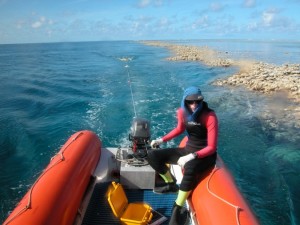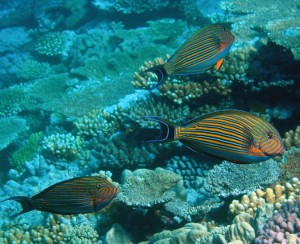NERP TE Project 1.1 - Monitoring status and trends of coral reefs of the Great Barrier Reef (AIMS)
Project summary
This project will continue a unique data set that documents long-term trends in coral reef communities of the Great Barrier Reef (GBR). Regular surveys of fish, coral and coral predators such as crown-of-thorns starfish on 47 reefs since 1992, provide the 'big picture' on the condition of reefs on the GBR and how they are changing over time. This project will employ a range of surveying techniques to detect events likely to have large-scale impacts on reef health, such as coral bleaching, coral disease, cyclones or crown-of-thorns starfish outbreaks.
Why this research is needed
Documenting patterns of reef decline and determining the factors influencing reef recovery is critical to the long-term persistence of the GBR. The surveys show that crown-of-thorns starfish and cyclones have been the leading causes of damage to coral reefs since the early 1990s when surveys began. These kinds of disturbances affect different areas of the GBRMP and their effects persist from years to decades, so long-term data sets are critical for understanding the ecology of coral reefs and for formulating policies to best protect them.
Research-user focus
This project provides information on condition of coral reefs over a large area of the Great Barrier Reef Marine Park and will contribute to the 2014 Great Barrier Reef Outlook Report to be produced by the Great Barrier Reef Marine Park Authority (GRBMPA) and the Department of Sustainability, Environment, Water, Population and Communities. Regular updates on reef status and crown-of-thorns starfish are provided to the Association of Marine Park Tourism Operators to provide early warning of any increases in crown-of-thorns starfish activity.
Outcomes
- Updates on status and temporal trends in coral, fish and crown-of-thorns starfish populations on survey reefs.
- Report on recovery rates and resilience of reefs after cyclones in 2009-2011.
- Report on crown-of-thorns starfish outbreaks on the GBR.
- Publications on coral and fish dynamics in relation to management and environmental drivers.
Reports, Publications and News
For more information see Project 1.1 'Monitoring status and trends of coral reefs of the Great Barrier Reef on the NERP Tropical Ecosystems Hub site.
Images
Datasets

This project will continue a unique data set that documents long-term trends in coral reef communities of the Great Barrier Reef (GBR). In 2012-13 and 2014-15 the LTMP will resurvey the ‘core’ reefs that have been surveyed since 1992.
70 selected reefs throughout the Great Barrier Reef (GBR) are sampled in the AIMS Long-term Monitoring Project (LTMP). Underwater visual census is used to survey reef fishes on fixed transects (3 sites per reef, 5 x 50 m transects per site). The abundance and length of all diurnally active, non-cryptic fishes are recorded. A full list of species observed each year can be obtained on request.
The overarching goal of LTMP fish surveys are to detect changes in reef fish communities over time at a regional scale, but also to examine the effectiveness of Marine Protected Areas.
Benthic organisms were surveyed annually on fixed sites in one habitat on each of 47 selected core survey reefs from 1993 to 2005 in 6 regions throughout the Great Barrier Reef (GBR). Surveys were undertaken at 3 sites per reef, with 5x50m transects surveyed per site.In 2004 a new zoning plan was implemented in the Great Barrier reef Marine Park and in 2006 the pattern of surveys was changed. The original set of reefs (47) are surveyed in odd years (e.g. 2007) and a different set (56 reefs) are surveyed in even years.
64 'key' reefs in 11 sectors of the Great Barrier Reef (Cape Grenville, Princess Charlotte Bay, Cooktown/Lizard Island, Cairns, Innisfail, Townsville, Cape Upstart, Whitsunday, Pompey Complex, Swain and Capricorn Bunker) are annually surveyed for crown-of-thorns starfish using the manta tow technique. An additional 117 reefs from the sectors (excluding the Whitsunday, Swain and Capricorn-Bunker sectors) are scheduled for survey every third year ('cycle' reefs).








